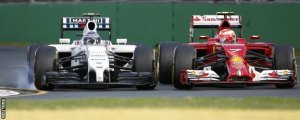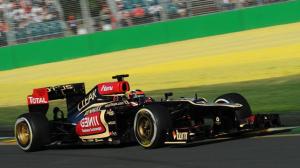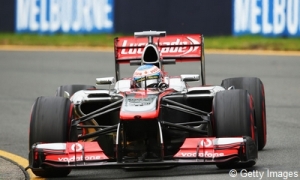So, that’s the first Formula 1 race of 2014 done and dusted. In some ways you could say that, despite the new 1.6 litre turbocharged hybrid power units and regulations changes, nothing has changed. We still had a German dominating the race, by breaking clear at the start, leading the way for the whole race and winning by a huge margin. In reality, though, we all know that the F1 of 2014 is different from 2013 in a whole raft of ways.
Firstly, of course, it wasn’t Sebastian Vettel – world drivers’ champion for the last four seasons in his Red Bull Renault – who dominated the race, but another young German in Mercedes driver Nico Rosberg. Such was the manner of Rosberg’s victory, though, that it was very reminiscent of Vettel’s past dominance. Rosberg won the race by a huge 24.5 seconds from Red Bull Racing’s new Australian driver Daniel Ricciardo (later excluded from the results after a fuel flow infraction), with McLaren’s Kevin Magnussen a further 2.2 seconds back.
While Red Bull Racing Team Principle Christian Horner’s prediction that Mercedes might win by a couple of laps proved to be very wide of the mark, it was certainly proved correct that Mercedes are enjoying a significant pace advantage over the rest of the field right now. Unfortunately for them, and for polesitter Lewis Hamilton, that pace has not come hand in hand with total reliability. Sadly for Hamilton, and for the race, he only managed to complete three laps because of a failed cylinder in his engine, which hampered him from the get go enabling Rosberg to cruise past him off the line. Hamilton, though, handled the understandable disappointment well; you suspect that his turn will come, and before long.
 There were also contrasting fortunes for the two Red Bull Racing cars in terms of race performance. To be honest, the world constructors champions did amazingly well to be anywhere near the front after a disastrous pre-season, but they confounded expectations by looking competative in Melbourne. While new boy Ricciardo was hugely impressive over the race weekend, both starting and finishing in second place before his subsequent exclusion from the results, his team-mate, reigning world champion Sebastian Vettel, did not enjoy the same sort of performance levels.
There were also contrasting fortunes for the two Red Bull Racing cars in terms of race performance. To be honest, the world constructors champions did amazingly well to be anywhere near the front after a disastrous pre-season, but they confounded expectations by looking competative in Melbourne. While new boy Ricciardo was hugely impressive over the race weekend, both starting and finishing in second place before his subsequent exclusion from the results, his team-mate, reigning world champion Sebastian Vettel, did not enjoy the same sort of performance levels.
Vettel was hampered by a software problem in qualifying, meaning that he could only manage to qualify in 13th place (he started 12th after a grid penalty for Valterri Bottas). In the race, he never really got going, dropping back at the start and completing just one more lap than Hamilton before being forced to retire. The frustration from the German was clear over team radio as he instructed his team to “Do something” while complaining of a lack of power and pace. Things aren’t quite so easy when you’re not in the dominant car and you suspect that this is something that Vettel will have to come to terms with, particularly in the early stages of the season.
While Mercedes cars, and in some ways the two Red Bulls, suffered contrasting fortunes the same cannot be said of a resurgent McLaren. Martin Whitmarsh’s departure, the return of Ron Dennis and the recruitment of Eric Boullier as Racing Director has coincided with a huge turnaround for the Woking-based team. McLaren struggled throughout 2013, finishing the season without scoring a single podium finish. They ended that run in the first race of 2014 with rookie Kevin Magnussen’s brilliant drive to third place on his F1 debut. Following Ricciardo’s exclusion this, of course, was upgrade to second.
Not only that, but Magnussen was followed home by team-mate Jenson Button who inherited third, meaning that McLaren leave Australia with a double-podium and the lead of the constructors championship. While all is not quite as the team would hope – they’re still lacking in outright pace in comparison to Mercedes – this is a massive leap forward for McLaren. They might not be the quickest, but they have proved that they’ve got consistency. Not only that, but the tactical errors that have blighted the team over the past couple of seasons look to have been eradicated. There was clear evidence of that as Jenson Button was moved forward through the pit stops from his 10th place starting position, leapfrogging cars with some good strategy, particularly when taking maximum advantage from the single safety car period – caused after Valterri Bottas brushed the wall in his Williams – by diving into the pits at the last possible moment.
While McLaren – the Mack of this article’s title – are clearly back amongst the front-runners, they’re certainly not the only ones. Williams were hugely impressive in pre-season and they seem to have carried that forward into the season proper, along with a new title sponsorship deal with Martini. Although they perhaps didn’t achieve the results that they might have hoped for in Australia, Bottas’s sixth place finish still resulted in eight world championship points for the Grove-based team. That’s three more than they managed for the whole of the previous season. Things might have been even better for the team had new recruit Felipe Massa not been taken out at the first corner by Caterham’s Kamui Kobayashi, and Bottas not brushed the wall at turn 10 on lap 10 when running in sixth position, triggering the safety car.
We’re only one race into the season, of course, but Williams and McLaren look to be back where they would say they belong. Ferrari, clearly have work to do – the Scuderia where never really in contention at Albert park, finishing fifth (Alonso) and eighth (Raikkonen) places (both upgraded following Ricciardo’s disqualification) – but not as much as Lotus who, as expected, struggled badly, with both cars forced to retire. Pastor Maldonado’s move from Williams to Lotus, is not looking like the wisest one right now.
One thing is clear, though, Mercedes are enjoying a significant pace advantage over their rivals. If they can maintain that throughout the season, and minimise the sort of reliability issues suffered by Hamilton, there’ll be no stopping them in 2014.






